A storage device made simple with 9 hard drives
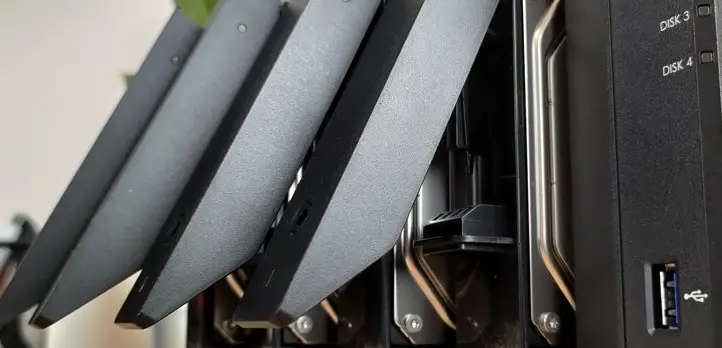
Synology has designed the DS920 + to handle nine hard disks, primarily for small businesses. Still, it can also be a practical tool for everyday users, such as family storage, because of its simplicity.
Anyone looking for their bread through photography and video will sooner or later be faced with the fact: they will need plenty of free storage space. Not only to back up the raw material but also to present our finished work to customers.
While cloud storage companies are bidding on each other for customers, services like Google One, Dropbox, or Microsoft OneDrive are trying to meet the needs of the public. For micro, small and medium businesses, this is why using a NAS can be a practical solution. We recently visited Synology’s product, the DS920 +, and we looked at what this unit is capable of.
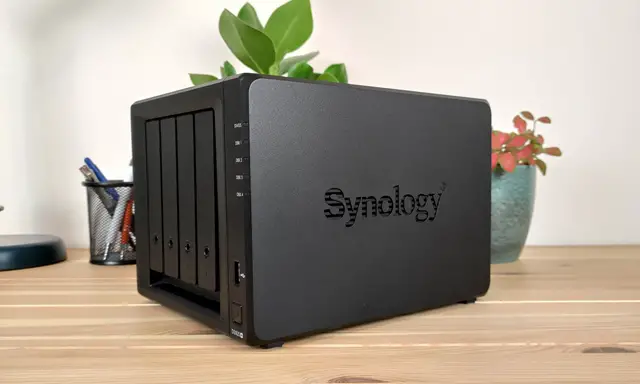
Before we delve deeper into what the DS920 + has to offer, it’s worth realizing what a NAS is. The acronym comes from Network Attached Storage, which means network data storage. It’s a simplistic server: its processor, cooling, and more severe storage capacity. Of course, the size of the latter depends on how much storage we have. In addition, it can automatically back up, access, and use your data not only from your home network but from virtually anywhere you have an Internet connection.
However, it’s important to note that a NAS — if it’s just about storing files — may not necessarily compete with cloud-based hosting services. To be worth investing in such an asset in terms of value for money as an ordinary user, we need to have a lot of data to store. The real advantage is much more in the services offered by the manufacturer – Synology for our test subject. But I’ll talk about that a little later.
Exterior
The Synology DS920 + fits in a relatively small space due to its compact size of NAS: 199 x 166 x 233 mm (width x height x depth). In the beginning, find four racks to place the hard disks. These bins are also very easy to open and close, and the HDDs can be snapped into place with a single snap without any particular tension. In the beginning, we were a little afraid not to break any of the ears, but in our experience, not even the many inserts and inserts wore the structure. And in real life, you probably won’t open it often, at most if you want to replace a hard drive in your machine.
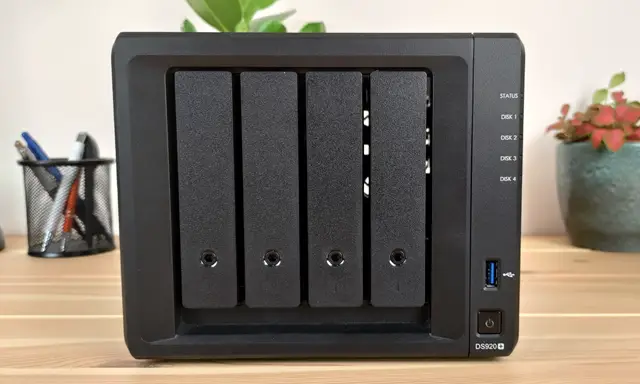
There is also a power button on the front of the device, a USB 3.0 socket, and LEDs that indicate the operation of the hard disks and the machine.
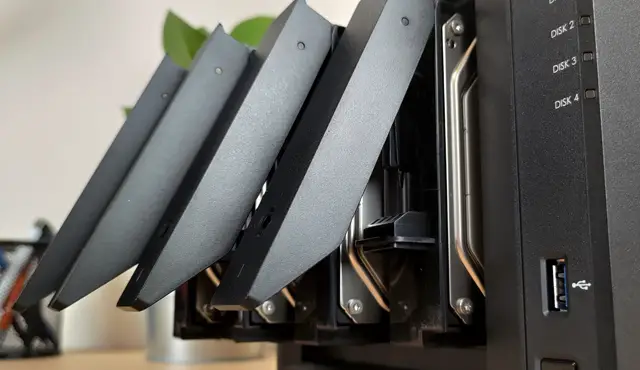
On the DS920 +, we only find Synology, but the back of the device already has a lot more to hide. First of all, here are the system fans – number two. It is important to note that this should only place the NAS not obscured by anything. Otherwise, the hard disks will not be adequately cooled.
On the back, you will find two more Ethernet connectors, an eSATA port, a USB 3.0 socket, and a network connector.

If we turn the DS920 + on top, we can find two more small doors at the bottom, but we can no longer add HDDs but SSDs to our system. And here, we have to stop for a moment and talk about what the device’s name says.
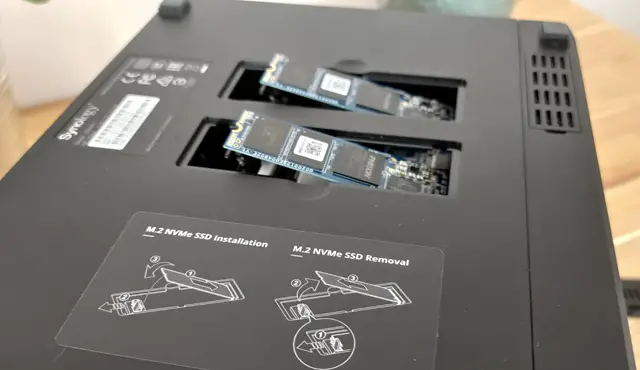
Synology usually names the NASs it manufactures to read out how many hard disks it can handle in total. The DS920 + means nine HDDs: we can put four in each of the four racks, and the connectors can be added to a five-disc device. This is how the math comes out: 4 + 5 = 9. However, SSDs are not included in this storage capacity, so as a result, the device can handle a total of 11 storage spaces.
As mentioned, a NAS is not just simple external storage but a separate computer. Inside the DS920 + is a quad-core, 2.0 GHz Intel Celeron J4125 processor, but the chip’s clock speed can be 2.7 GHz for increased data processing.
It all comes with 4GB of DDR4 RAM, which at first doesn’t seem like much – considering that mobiles already have 8-12 and even 16GB of RAM – but in our experience, this configuration is plenty to do tasks back up. There is undoubtedly a faster structure on the market, but the possible lack of speed has not occurred. However, anyone who still wants more memory can expand it to 8 GB.
The possibility of a wireless connection was left out of this device, which is a bit of a painful point, considering that one often wants to back up not only through one’s computer but also from one’s phone.
Benefits
Although at first, one would think that a NAS is complicated to use, in reality, this is not the case at all. Of course, it’s not as simple as an external hard drive, but it doesn’t take much more to do it in practice.
Once the hard drives are installed, the first step is to connect the DS920 + to the router – using a LAN cable – and then we can boot the system. Once turned on, we need to perform a simple installation process using our browser.
Software created for this purpose first formats the repositories and then installs the files required for operation. In our experience, this didn’t last more than 10 minutes. You can also set the name to access the NAS remotely later during installation. We need to pay special attention to this step so that we can reach our unit remotely, via the Internet in the future.

After the installation, you can see a similar interface to what you are used to with, for example, your Windows computer. But instead of installing a new browser as a first step, you may want to open the Package Management Center, as this will be of great help to you later. Here are the applications we can use to get our NAS to work.
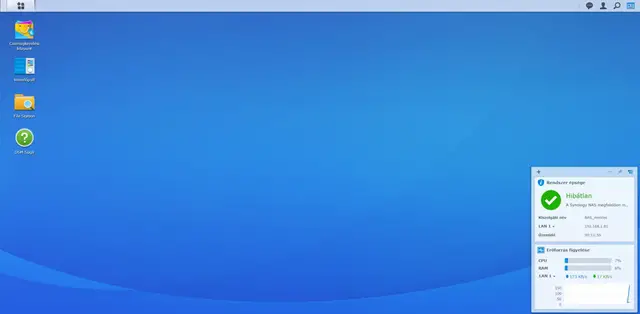
And here we have to decide right away the most important question (if we haven’t done it before): what do we want to use the structure for? For example, if you want to store media files on it — such as the videos we’ve created that represent our portfolio — you might want to install the Media Server app, but if you’re into photography, an app called Photo Station will be the most popular important to us. But you can install the chat server on your device, complicate your mail, or use it as a Proxy Server.

Apps are pretty easy to install on your device to do so on your mobile. Their setup is already a bit more complicated, but the system guides the user through the essential steps. Staying with the photographer’s example, once a client has a job done, we can share it with them by giving them direct access to the NAS — more specifically, the directory containing the relevant files.
A separate link is generated for us by the photo management app, and in fact, it also allows us to password protect the data. As a result, the content can be even more secure, as only those who have the right to do so will be able to crawl the path.

With the help of the status indicator built into the device’s system, we can also monitor the structure’s performance, so it is also easy to spot if someone is using the system.
Summary
Positive: quiet operation, easy operation, ample range of applications, stable system.
Negative: No wireless communication, more for business use.
What we feared would make the device loud because of the two fans has not been proven. However, you still have to get used to the hum of it, especially if you have been using a laptop with an SSD for many years.
Although Synology offers the DS920 + NAS for home use and business, it needs to belong to the former target group to take advantage of the structure. If only because the price is around 210 on the domestic market, and this only includes the device, hard drives and SSDs are not included.
If you only want to use the device to store your files, you may not get the price back soon, but we can already talk about a good value for money with applications.



